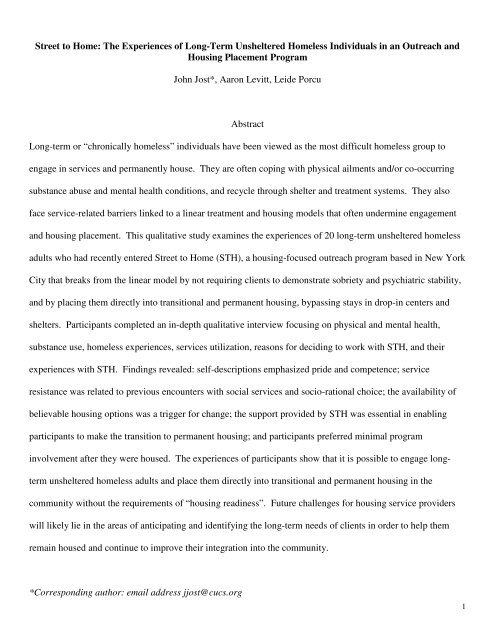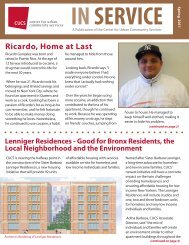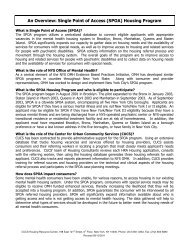Street to Home: The Experiences of Long-Term Unsheltered ...
Street to Home: The Experiences of Long-Term Unsheltered ...
Street to Home: The Experiences of Long-Term Unsheltered ...
Create successful ePaper yourself
Turn your PDF publications into a flip-book with our unique Google optimized e-Paper software.
<strong>Street</strong> <strong>to</strong> <strong>Home</strong>: <strong>The</strong> <strong>Experiences</strong> <strong>of</strong> <strong>Long</strong>-<strong>Term</strong> <strong>Unsheltered</strong> <strong>Home</strong>less Individuals in an Outreach andHousing Placement ProgramJohn Jost*, Aaron Levitt, Leide PorcuAbstract<strong>Long</strong>-term or “chronically homeless” individuals have been viewed as the most difficult homeless group <strong>to</strong>engage in services and permanently house. <strong>The</strong>y are <strong>of</strong>ten coping with physical ailments and/or co-occurringsubstance abuse and mental health conditions, and recycle through shelter and treatment systems. <strong>The</strong>y als<strong>of</strong>ace service-related barriers linked <strong>to</strong> a linear treatment and housing models that <strong>of</strong>ten undermine engagementand housing placement. This qualitative study examines the experiences <strong>of</strong> 20 long-term unsheltered homelessadults who had recently entered <strong>Street</strong> <strong>to</strong> <strong>Home</strong> (STH), a housing-focused outreach program based in New YorkCity that breaks from the linear model by not requiring clients <strong>to</strong> demonstrate sobriety and psychiatric stability,and by placing them directly in<strong>to</strong> transitional and permanent housing, bypassing stays in drop-in centers andshelters. Participants completed an in-depth qualitative interview focusing on physical and mental health,substance use, homeless experiences, services utilization, reasons for deciding <strong>to</strong> work with STH, and theirexperiences with STH. Findings revealed: self-descriptions emphasized pride and competence; serviceresistance was related <strong>to</strong> previous encounters with social services and socio-rational choice; the availability <strong>of</strong>believable housing options was a trigger for change; the support provided by STH was essential in enablingparticipants <strong>to</strong> make the transition <strong>to</strong> permanent housing; and participants preferred minimal programinvolvement after they were housed. <strong>The</strong> experiences <strong>of</strong> participants show that it is possible <strong>to</strong> engage longtermunsheltered homeless adults and place them directly in<strong>to</strong> transitional and permanent housing in thecommunity without the requirements <strong>of</strong> “housing readiness”. Future challenges for housing service providerswill likely lie in the areas <strong>of</strong> anticipating and identifying the long-term needs <strong>of</strong> clients in order <strong>to</strong> help themremain housed and continue <strong>to</strong> improve their integration in<strong>to</strong> the community.*Corresponding author: email address jjost@cucs.org1
ReferencesApplewhite, S.L. (1997). <strong>Home</strong>less veterans: perspectives on social service use. Social Work, 42, 19-30.Asmussen, S.M., Romano, J., Beatty, P., Gasarch, L., &. Shaughnessey, S. (1994). Oldanswers for <strong>to</strong>day’s problems: helping integrate individuals who are homeless with mental illnesses in<strong>to</strong>existing community-based programs. Psychosocial Rehabilitation Journal, 17, 17-34.Bhui, K., Shanahan, L. & Harding, G. (2006). <strong>Home</strong>lessness and mental illness: aliterature review and a qualitative study <strong>of</strong> perceptions <strong>of</strong> the adequacy <strong>of</strong> care. International Journal <strong>of</strong>Social Psychiatry, 52(2), 152-165.Dickson-Gomez, J., Convey, M., Jilario, H., Corbett, A.M., & Weeks, M. (2007). Un<strong>of</strong>ficial policy: access <strong>to</strong>housing, housing information and social services among homeless drug users in Hartford,, Connecticut.Substance Abuse Treatment, Prevention, and Policy, 2:8Fisk, D., Rakfeldt, J., & McDormick, E. (2006). Assertive outreach: An effectivestrategy for engaging homeless persons with substance use disorders in<strong>to</strong> treatment. American Journal<strong>of</strong> Drug and Alcohol Abuse, 32, 479-486.Geertz, C. (1973). Thick description: Toward an interpretive theory <strong>of</strong> culture. <strong>The</strong>interpretation <strong>of</strong> cultures: Selected essays (Chapter 1). New York: Basic Books.Hopper, K., Jost, J., Hay, T., Welber, S., & Haugland, G. (1997). <strong>Home</strong>lessness, severemental illness and the institutional circuit. Psychiatric Services, 48(10), 659-665.Hopper, K. (2006). Redistribution and its discontents: on the prospects <strong>of</strong> committedwork in public mental health and like settings. Human Organizations, 65(2), 218-226.Lipsky, M. (1980). <strong>Street</strong>-level bureaucracy: Dilemmas <strong>of</strong> the individual in public services. New York, NY:Russell Sage Foundation.Morse, G.A., Calsyn, R.J., Miller, J., Rosenberg, P., West, L., & Gilliland, J. (1996).Outreach <strong>to</strong> homeless mentally ill people: conceptual and clinical considerations. Community MentalHealth Journal, 32(3), 261-274.Mojtabai, R. (2005). Perceived Reasons for loss <strong>of</strong> housing and continued homelessnessamong homeless persons with mental illness. Psychiatric Services, 56(2), 172-178.National Registry <strong>of</strong> Evidence-based Practices and Programs. (2007, November). Retrieved May 15, 2008,from http://www.nrepp.samhsa.gov/programfull details.asp?PROGRAM_ID=195Osher, F. & Drake, R. (1996). Reversing a his<strong>to</strong>ry <strong>of</strong> unmet needs: approaches <strong>to</strong> carefor persons with co-occurring addictive and mental disorders. American Journal <strong>of</strong> Orthopsychiatry, 66,4-11.Padgett, D. (2007). <strong>The</strong>re’s no place like (a) home: On<strong>to</strong>logical security among personswith serious mental illness in the United States. Social Science & Medicine, 64, 1925-1936.2
Randall, G. & Brown, S. (2002). Helping rough sleepers <strong>of</strong>f the streets. Office <strong>of</strong> the Deputy Prime Minister,London, UK.Ridgeway, P. & Zipple, A.M. (1990). <strong>The</strong> paradigm shift in residential services: From the linear continuum <strong>to</strong>supported housing approaches. Psychosocial Rehabilitation Journal, 13, 11-31.Rosenblum, A., Nuttbrock, L., McQuistion, H., Magura, S., & Joseph, H. (2002).Medical outreach <strong>to</strong> homeless substance users in New York City: preliminary results. Substance Abuse& Misuse, 37(8-10), 1269-1273.Rosenheck, R.A. & Lam, J. (1997). Client and site characteristics as barriers <strong>to</strong> service use by homelesspersons with serious mental illness. Psychiatric Services, 48(3), 387-390.Rosenheck, R.A., Lam, J., Morrissey, J.P., Calloway, M.O., S<strong>to</strong>lar, M., Randolph, F., etal. (2002). Service systems integration and outcomes for mentally ill homeless persons in the ACCESSprogram. Psychiatric Services, 53(8), 958-966.Rowe, M., Fisk, D., Frey, J., & Davidson, L. (2002). Engaging persons with substanceuse disorders: Lessons from homeless outreach. Administration and Policy in Mental Health, 29(3),263-273.Schutt, R.K., & Goldfinger, S.M. (1996). Housing preferences and perceptions <strong>of</strong> healthand functioning among homeless mentally ill persons. Psychiatric Services, 47(4), 381-386.Sosin, M.R., & Bruni, M. (1997). <strong>Home</strong>lessness and vulnerability among adults withand without alcohol problems. Substance Use & Misuse, 32(7-8), 939-968.Sosin, M.R., & Bruni, M. (2000). Personal and situational perspectives on rejection <strong>of</strong> ahomelessness and substance abuse program: An explora<strong>to</strong>ry study. Social Work Research, 24(1), 16-27.Sosin, M.R., & Grossman, S.F. (2003). <strong>The</strong> individual and beyond: a socio-rational choice model <strong>of</strong> serviceparticipation among homeless adults with substance abuse problems. Substance Use & Misuse, 38(3-6),503-549.Strauss, A.L., & Corbin, J. (1990). Basics <strong>of</strong> qualitative research: Grounded theoryprocedures and techniques. Newbury Park, CA: Sage.Stefancic, A., & Tsemberis, S. (2007). Housing first for long-term shelter dwellers withpsychiatric disabilities in a suburban county: a four-year study <strong>of</strong> housing access and retention. Journal<strong>of</strong> Primary Prevention, 28, 265-279.Susser, E., Valencia, E., Conover, S., Felix, A., Wei-Yann, T., & Wyatt, R.J. (1997).Preventing recurrent homelessness among mentally ill men: A “critical time” intervention afterdischarge from shelter. American Journal <strong>of</strong> Public Health, 87, 256-262.Tommasello, A.C., Myers, C.P., Gills, L., Treherne, L.L. & Plumh<strong>of</strong>f, M. (1999).Effectiveness <strong>of</strong> outreach <strong>to</strong> homeless substance abusers. Evaluation and Program Planning, 22(3),295-303.Tsemberis, S., Gulcur, L., & Nakae, M. (2004). Housing first, consumer choice, and3
harm reduction for homeless individuals with dual diagnosis. American Journal <strong>of</strong> Public Health, 94(4),651-656.U.S. Department <strong>of</strong> Housing and Urban Development. (2006). A Guide <strong>to</strong> Counting <strong>Unsheltered</strong> <strong>Home</strong>lessPeople Revised.Ware, N.C., Tugenberg, T., & Dickey, B. (2004). Practitioner relationships and quality<strong>of</strong> care for low-income persons with serious mental illness. Psychiatric Services, 55(5), 555-559.4









